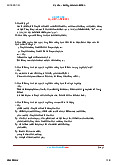
Preview text:
Floods in Vietnam are caused by a combination of natural and human factors. Natural Factors:
1. Vietnam's vulnerability to flooding stems from a combination of natural factors.
The country experiences heavy monsoon rains during the wet season from May to
October, leading to extensive flooding in low-lying areas and along river basins.
2. Additionally, Vietnam's diverse topography, which includes mountainous regions in
the north and central areas, as well as low-lying delta regions in the south such as
the Mekong Delta and Red River Delta, exacerbates the risk of flooding. These
geographical features contribute to the country's susceptibility to inundation,
highlighting the need for effective flood management strategies to mitigate the
impact on vulnerable communities and infrastructure.
3. Climate change is also the reason leading to more frequent and intense extreme
weather events, including heavy rainfall and storms, which can increase the
likelihood of flooding in Vietnam and other vulnerable regions. Human Factors:
1. Deforestation: Deforestation, particularly in upland areas, can exacerbate flooding
by reducing the ability of forests to absorb rainfall and stabilize soil. This can lead
to increased surface runoff and soil erosion, which contribute to flash floods and landslides.
2. Urbanization: Rapid urbanization and inadequate urban planning can lead to the
paving over of natural surfaces, reducing the land's ability to absorb rainfall.
Additionally, poorly designed drainage systems in urban areas can exacerbate flooding during heavy rains.
3. Poor Infrastructure: Inadequate infrastructure for flood control, such as levees,
embankments, and drainage systems, can contribute to the severity of flooding
events by failing to adequately manage and divert floodwaters away from populated areas.




